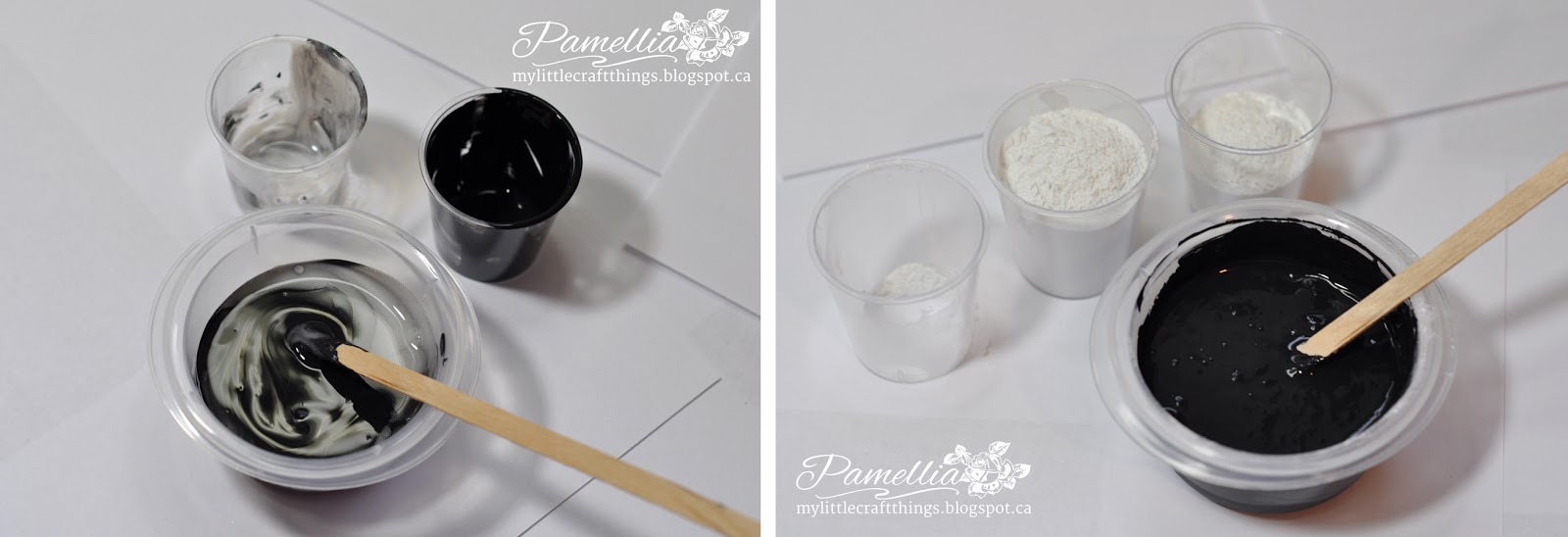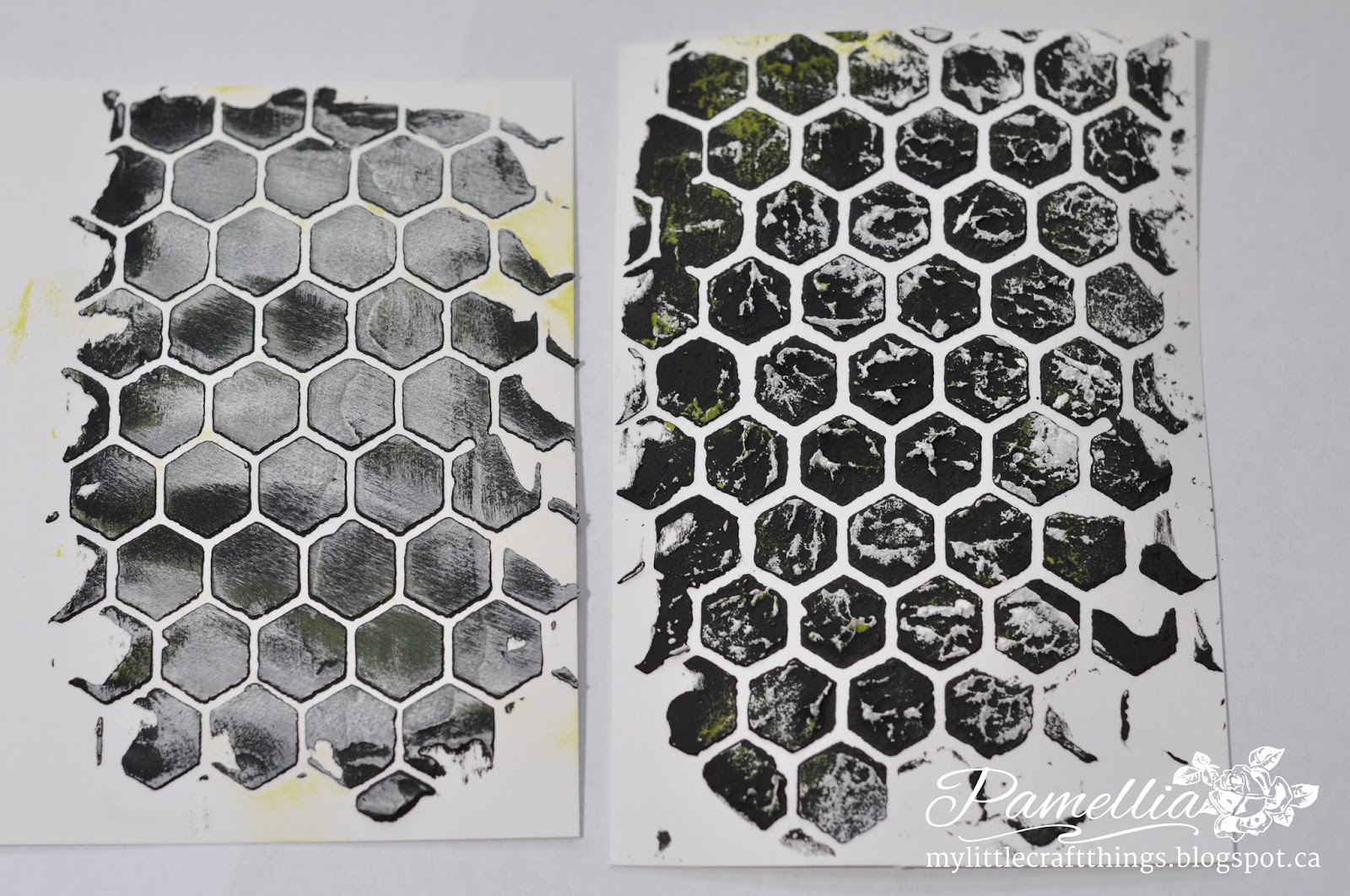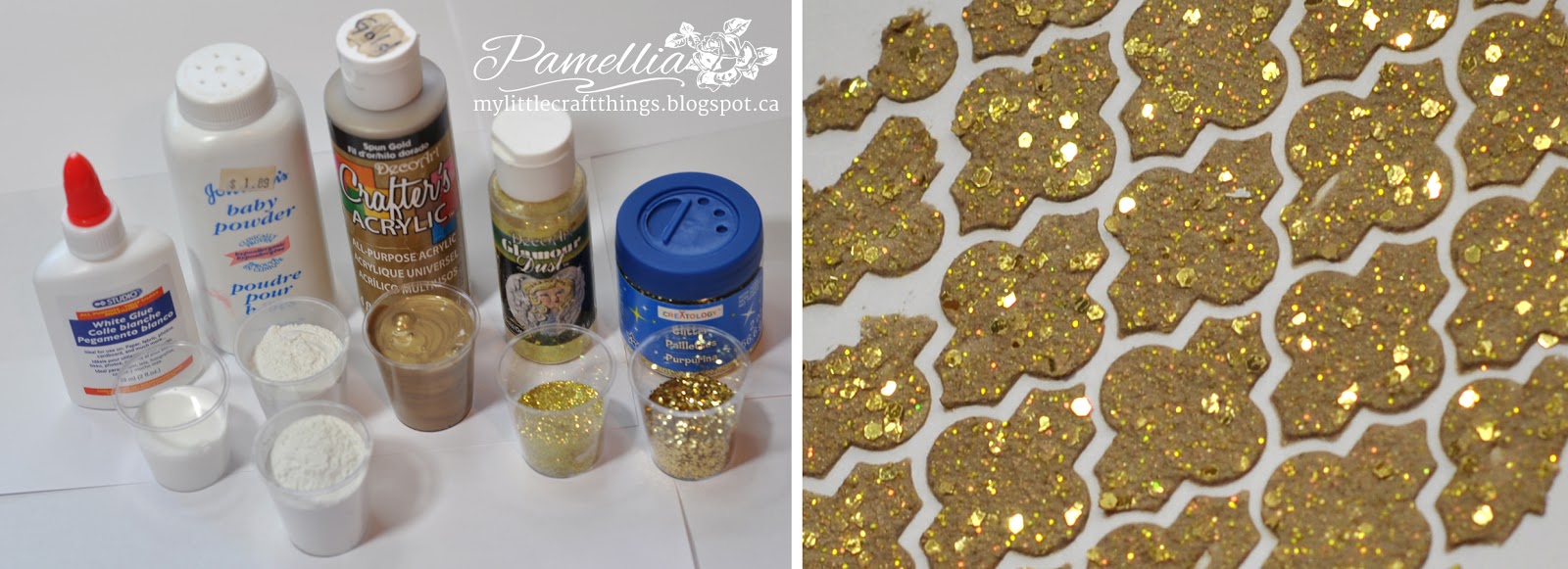Home-made Texture Paste & Glitter Paste Tutorial By
Pamellia Johnson
Hello Everyone!
I have been getting a lot of questions regarding my home-made texture
paste, so I thought it was about time I let you in on how I make it. By
no means did I invent the concept, but I did spend a lot of time and
products perfecting my ratio formula, so I feel that I can call this my
own recipe. I have included 3 different versions today, all of which
have great uses for different things and all of them are ratio recipes.
The advantage of a ratio recipe is you can make as much or as little as
you want, all you have to do is change the size of your portion
container!!
OK, here we go...
RECIPE #1 - STICKY PASTE
INGREDIENTS:
-
Baby powder or talc powder - white, non-scented is always good.
The perfume magnifies under heat, so you be the judge of how much time
you can spend breathing in those fumes.
-
White Glue - cheap, dollar store glue actually works great. The
only thing you don't want is glue that dries too fast or glue that is
really shiny when it dries.
-
Acrylic Paint - again, just some cheap, dollar store paint will do the trick! Nothing fancy required!
-
Portion Cups - I use plastic ounce glasses from the party supply store which makes about 1/3 cup of paste
You will also need a container to mix in that can be sealed air tight and something to stir with.
RECIPE:
- 1 portion of paint, 1/2 portion of glue and 2 portions of powder
DIRECTIONS:
- put your wet ingredients in first (the glue and paint), then just like
when your making tea biscuits or a pie crust...slowly add the baby
powder, making sure to stir well. This will ensure that you get out all
of the lumps making it nice and creamy and easier to spread...just like
your pastry!!!
BEST USE FOR STICKY PASTE: This is the paste you want to use if you
would like to sprinkle on a little glitter or embossing powder. It is
also great if you want a smooth pattern with crisp edges.
PRO'S - It is really smooth, so it spreads easily. It is really wet, so
the glitter and embossing powders stick to it really well. Because of
the slower drying time, you have leeway for clean up and putting the cap
back on. It makes a wonderful, clean, crisp pattern once it dries.
Perfect for elegant or CAS style cards.
CON'S - It is really wet, so it takes a lot longer to dry and warps the
paper more. You won't get a good texture with it because it isn't stiff
enough to maintain peaks and grooves. You also cannot lay it on very
thick or it just falls like a badly baked soufflé!
In this sample, I sprinkled on some gunmetal glitter.
In this sample, I sprinkled on black embossing powder. You can get two
looks from this. If you leave it the way it is, it has a soft velvety
appearance and feel to it. Or you can use your heat gun and melt it like
you normally would for a shiny surface (that will also act as a resist
to preserve the colour of your paste when you start inking).
If you decide to melt your embossing powder, be sure to wait until your
paste is completely dry before taking the heat gun to it. If the paste
is still wet, the powder will burn long before it melts. You can see
below, half I left as it was and the other half I melted with the heat
gun (too soon, I might add) lol.
RECIPE #2 - DRY PASTE
The only difference between the recipe for sticky paste and dry paste is
that the dry paste has 1/2 portion extra of baby powder added to it
(depending on the brands of paint and glue, you may have to add a bit
more powder). Here is a shot so you can see the difference in shine and
consistency.
BEST USE FOR DRY PASTE: This is the paste you want to use if you are
going for texture. It's the base for my bark technique and it also makes
great clouds, wood planks, ocean waves and all sorts of other textures.
PRO'S - It has less glue and paint, so the drying time is considerably
less than the sticky paste and it also doesn't warp your paper too
badly. It's, of course, fantastic for texture and depth because you can
lay it on thick and mold it! It looks great on vintage or grungy
projects.
CON'S - Don't leave the lid off because it will dry out crazy fast,
right in your container! It can be a little harder to spread because
it's so thick and pasty - and make sure you wash your stencil right away
or it will crust right on.
Here is one done with Sticky Paste and one done with Dry Paste, so you
can see the difference in the finished textures. I have spread some
yellow and white paint on it to make it easier for you to see.
RECIPE #3 - GLITTER PASTE
INGREDIENTS:
-
Baby powder or talc powder - same as before.
-
White Glue - same as before.
-
Metallic or Pearl Paint - again, just cheap acrylic paint is fine. If you don't have metallic, that's ok, it just adds a little extra shimmer is all.
-
Fine Glitter - Any brand will do, although the boldest,
brightest versions work the best. This is the glitter that will blend in
with the paint to give it an overall shimmer.
-
Coarse Glitter - The coarse glitter is what will grab the light and really make it sparkle.
For the coarse glitter, I recommend the flat octagon style of glitter.
Most cheap glitters for kids crafts will be great for this. I know we
all love our Frantage, but those chunks do not spread, they drag and
leave gaps in the paste. Tim Holtz distress glitter, I'm sad to say,
does not work either. It's not quite sparkly enough and gets coated with
the paint, never to be seen again. Here are the glitters that I
use...lots of shimmer to them.
RECIPE:
- 1 portion paint, 1/2 portion glue, 2 portions powder, 1/2 portion fine glitter and 1/2 portion coarse glitter
BEST USE FOR DRY PASTE: Christmas, of course, but pretty much any other project too!
PRO'S - You absolutely cannot get a beautiful shimmer and texture like
this, simply by sprinkling glitter on top of a product! And as a bonus,
it's so freaking cheap, you can make some in every colour!!
CON'S - You may never want to use plain texture paste again!!
In this sample I used pearl paint and iridescent glitters, you should really zoom in and check it out!
Well, I hope you enjoyed my really long winded tutorial! If anyone tries
out my recipe and has some success, I would really love to see your
projects!! Come on back and leave me a link, so I can swoon over your
wonderful creations!
I will be leaving a permanent link on my Tutorials Page, in case you can't find this post.
That's it for today. Thank you for stopping in and for all the amazing
comments. I read and appreciate every single one! If you have any
questions, please let me know.
Recipe Copied from: http://mylittlecraftthings.blogspot.ca/2014/09/home-made-texture-paste-glitter-paste.html












































